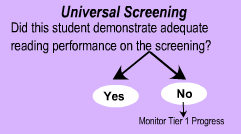How will teachers initially identify struggling readers?
Page 3: Identification of Struggling Readers
Click on the movie below to learn about Rosa Parks’s universal screening plan (time: 1:00).
Transcript: Rosa Parks’s Universal Screening Plan
Last year, the S-Team members at Rosa Parks Elementary School considered all their options for conducting universal screenings. They decided that they would like to screen three times per year because it would help them to continue to identify students who are struggling and who need to have their progress monitored to determine if they require additional support or intervention. After reviewing different measures and criteria for identifying struggling readers, the team decided that they would administer a Dolch sight word list as their universal screening assessment for first grade. They did so because this assessment can be administered quickly and easily, is appropriate for first-grade students, and has alternate forms. Based on last year’s achievement test scores, the S-Team noticed that approximately 25 percent of students were struggling with reading. Therefore, they thought it reasonable to use the results of the universal screening to identify the bottom 25 percent of each first-grade class and to monitor their progress.
See the table below for the Rosa Parks Elementary universal screening plan.
| Universal Screening Assessment Options | Rosa Parks’s Decisions |
|---|---|
| Frequency of the screening | Three times per year (fall, winter, and spring) |
| Screening measure | Dolch sight word list |
| Criteria used to determine which students are in need of intervention | Bottom 25 percent of each first-grade class* |
* Although research indicates that some 20–30% of students in the early elementary grades struggle with reading, it may be necessary to progress monitor as many as 50% of the students in classrooms to determine which students are truly in need of intervention.
 Before going further, please note that this module describes just one way of implementing assessment procedures for RTI. For the sake of example, we chose to utilize a variety of assessment measures for universal screening and progress monitoring. However, in a school setting, this may not be the most desirable or practical option.
Before going further, please note that this module describes just one way of implementing assessment procedures for RTI. For the sake of example, we chose to utilize a variety of assessment measures for universal screening and progress monitoring. However, in a school setting, this may not be the most desirable or practical option.
Administration of the Universal Screening
 Mrs. Hernandez, a first-grade teacher at Rosa Parks, individually administered the Dolch sight word list (a random selection of 100 high-frequency words at the first-grade reading level) to each student in her class. To do so, she set aside the last 10 minutes of regularly scheduled silent reading. She was excited to be finished with the universal screenings after only four days.
Mrs. Hernandez, a first-grade teacher at Rosa Parks, individually administered the Dolch sight word list (a random selection of 100 high-frequency words at the first-grade reading level) to each student in her class. To do so, she set aside the last 10 minutes of regularly scheduled silent reading. She was excited to be finished with the universal screenings after only four days.
Listen as Mrs. Hernandez administers a first-grade Dolch sight word list to two of her students, Mai and LaToya. Click on each student’s picture below to hear the administration of the assessment and how Mrs. Hernandez records their performance.
Mai’s Dolch Sight Word List
Mrs. Hernandez: Hi, Mai. I want you to read these words as quickly and correctly as you can. Start here and go down the page. If you don’t know a word, skip it and try the next word. Keep reading until I say “stop.”
Mai: Reads the word list in the movie.
Mrs. Hernandez: Okay, stop.
Narrator: As Mai reads, Mrs. Hernandez marks a “1” for words she reads correctly and a “0” for words she reads incorrectly. When the 1-minute time limit is up, Mrs. Hernandez circles the last word read by Mai. To score this assessment, Mrs. Hernandez counts up the number of words read correctly in one minute and writes the score at the bottom of the scoring form.
LaToya’s Dolch Sight Word List
Mrs. Hernandez: Hi, LaToya. I want you to read these words as quickly and correctly as you can. Start here and go down the page. If you don’t know a word, skip it and try the next word. Keep reading until I say “stop.”
LaToya: Reads the word list in the movie.
Mrs. Hernandez: OK, stop.
Narrator: As LaToya reads, Mrs. Hernandez marks a “1” for words she reads correctly and a “0” for words she reads incorrectly. When the one-minute time limit is up, Mrs. Hernandez circles the last word read by LaToya. To score this assessment, Mrs. Hernandez counts up the number of words read correctly in one minute and writes the score at the bottom of the scoring form.
Decision-Making Based on the Universal Screening Results
 Having administered the universal screening measure, Mrs. Hernandez rank-ordered the students in her class based on their scores. She identified the bottom 25 percent of the class as struggling readers based on the criterion set by the S-Team. The figure on the right illustrates the RTI decision-making process for universal screening. Mrs. Hernandez will monitor the progress of these students over the next eight weeks to see who may need more targeted intervention.
Having administered the universal screening measure, Mrs. Hernandez rank-ordered the students in her class based on their scores. She identified the bottom 25 percent of the class as struggling readers based on the criterion set by the S-Team. The figure on the right illustrates the RTI decision-making process for universal screening. Mrs. Hernandez will monitor the progress of these students over the next eight weeks to see who may need more targeted intervention.
Below are the results of the universal screening assessment for Mrs. Hernandez’s class. The students scoring in the bottom 25 percent of the class are DeJuan, Megan, Ryan, LaToya, and Jack. Mrs. Hernandez will monitor these students during Tier 1 instruction to determine whether they are responding adequately.
| Student name | Number of words read correctly in one minute |
|---|---|
| Hannah | 20 |
| Emma | 17 |
| Joshua | 16 |
| Mai | 16 |
| Chuck | 15 |
| Aidan | 14 |
| Miguel | 14 |
| Deangelo | 13 |
| Mario | 13 |
| Sophia | 12 |
| Ethan | 12 |
| Gabriella | 12 |
| Yeojin | 12 |
| Caleb | 11 |
| Shante | 11 |
| Katharine | 10 |
| Abigail | 9 |
| DeJuan | 7 |
| Megan | 4 |
| Ryan | 4 |
| LaToya | 3 |
| Jack | 2 |
Activity
The S-Team at Rosa Parks could have used a number of different methods to identify struggling readers.
The S-Team at Rosa Parks could have used a number of different methods to identify struggling readers. Below are the results for Mrs. Hernandez’s class for two other assessment methods: using a CBM probe and using scores on a standardized achievement test.
| Student Name | Dolch Sight Word List (number of words read correctly in one minute) | Vanderbilt University Word Identification Fluency Probe Scores (number of words read correctly in one minute) | Standardized Achievement Test Percentile Ranks |
| Hannah | 20 | 35 | 89 |
| Emma | 17 | 30 | 80 |
| Joshua | 16 | 27 | 70 |
| Mai | 16 | 25 | 65 |
| Chuck | 15 | 21 | 67 |
| Aidan | 14 | 20 | 58 |
| Miguel | 14 | 20 | 60 |
| Deangelo | 13 | 20 | 57 |
| Mario | 13 | 19 | 56 |
| Sophia | 12 | 19 | 55 |
| Ethan | 12 | 18 | 57 |
| Gabriella | 12 | 17 | 51 |
| Yeojin | 12 | 14 | 50 |
| Caleb | 11 | 16 | 45 |
| Shante | 11 | 15 | 48 |
| Katharine | 10 | 16 | 25 |
| Abigail | 9 | 14 | 19 |
| DeJuan | 7 | 13 | 24 |
| Megan | 4 | 8 | 10 |
| Ryan | 4 | 5 | 27 |
| LaToya | 3 | 4 | 4 |
| Jack | 2 | 2 | 1 |
Note: Only scores for the Dolch sight word list have been rank-ordered.
Questions:
- Identify the students who fall below the established benchmark—15 words read correctly in one minute—on the Vanderbilt University Word Identification Fluency probe.
- Identify the students scoring at or below the 25th percentile on the standardized achievement test (a criterion set by the local school district, based on the school’s resources and students’ needs).
- How do the results for each of these assessments compare to the results of the Dolch sight word list assessment?
- Are the same students identified as poor readers?
- Will the number of students identified by each assessment impact the available school resources? Explain.
-
Identify the students who fall below the established benchmark—15 words read correctly in one minute—on the Vanderbilt University Word Identification Fluency probe.
When given the Vanderbilt University Word Identification Fluency probe, seven students fell below the criterion of 15 words read correctly per minute (wcpm):
Yeojin
MeganAbigail
JackDeJuan
LaToyaRyan -
Identify the students scoring at or below the 25th percentile on the standardized achievement test.
The six students scoring at or below the 25th percentile on the standardized achievement test were:
Katharine
RyanAbigail
JackDeJuan
LaToya -
How do the results for each of these assessments compare to the results of the Dolch sight word list assessment?
-
Are the same students identified as poor readers?
Although some of the same students (Dejuan, Ryan, Jack, and Latoya) were identified as struggling readers by all three assessments, each assessment produced different results. The Vanderbilt University Word Identification Fluency probe identified Yeojin and Abigail in addition to the five students who were identified by the Dolch sight word list. The standardized achievement test also identified Abigail as a struggling reader, but Katharine was identified instead of Yeojin or Megan. -
Will the number of students identified by each assessment impact the available school resources? Explain.
A different number of students were identified for each assessment as indicated below:- Bottom 25 percent of class on Dolch sight word list = 5 students
- Below 15 wcpm on Vanderbilt University Word Identification Fluency probe = 7 students
- At or below the 25th percentile on the standardized achievement test = 6 students
In cases in which more students are identified, the teacher will spend more time administering progress monitoring probes and perhaps providing additional instructional supports. Also, if more students require Tier 2 instruction, the school may need to hire more highly qualified school personnel to provide this instruction.
-
Help Mrs. Hernandez to identify the struggling readers using these results.
To review, Mrs. Hernandez administered the universal screening measure to all of her students, and she identified the struggling readers in her class. Mrs. Hernandez is continuing to provide high-quality instruction to the entire class and will monitor the progress of her five struggling readers.

